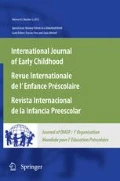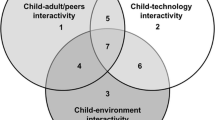Abstract
Museum visits can offer rich learning environments for preschool children. In potentiating learning environments, power is shared between adults and children as children and teachers co-construct understanding. Such learning environments also maximise opportunities for dialogue between adults, children and their peers. Drawing on the findings from a larger research project that involved preschool-aged children who attended a kindergarten located in a national museum, this paper reports a case study about one child’s learning as well as the activities of the preschool teachers and children before, during and after museum visits to an exhibition that focused on the weaving of Māori ceremonial cloaks. The case study demonstrates how one child’s artistic and imaginative capacities were strengthened through the dialogues and experiences surrounding the visits to the exhibition. Actions of the teachers included the teaching and learning processes of explaining, orchestrating, commentating, modelling, and reifying. Interactions between the child, her peers, the teachers, and the artefacts in the museum enriched this child’s developmental experiences.
Résumé
La visite d’un musée peut offrir un environnement éducatif très riche pour les enfants d’âge préscolaire. En potentialisant les environnements éducatifs, le pouvoir est partagé entre les adultes et les enfants, alors qu’enfants et enseignants co-construisent leur compréhension. De tels environnements maximisent aussi les occasions de dialogue entre les adultes, les enfants et leurs pairs. S’appuyant sur les résultats d’un projet de recherche plus large auquel participaient des enfants d’âge préscolaire qui fréquentaient une école maternelle située dans un musée national, cet article rapporte une étude de cas sur l’apprentissage d’un enfant ainsi que les activités des enseignants et des enfants avant, pendant, et après les visites d’une exposition sur le tissage de capes cérémonielles maories. L’étude de cas montre comment les capacités artistiques et imaginatives d’un enfant étaient renforcées par les dialogues et les expériences entourant les visites de l’exposition. Les actions des enseignants incluaient les processus d’enseignement et d’apprentissage suivants: expliquer, orchestrer, commenter, modeler et matérialiser. Les interactions entre l’enfant, ses camarades, les enseignants et les artefacts du musée enrichissaient les expériences développementales de cette enfant.
Resumen
Las visitas al Museo pueden ofrecer un valioso ambiente de aprendizaje para los niños en edad de preescolar. Para potenciar los ambientes de aprendizaje, este poder es compartido entre adultos y niños, en la medida en que los niños y los profesores construyen en conjunto el entendimiento. Dichos entornos de aprendizaje maximizan también las oportunidades para el diálogo entre adultos, niños y sus compañeros. Basándose en los descubrimientos de un amplio proyecto de investigación que incluyó niños en edad preescolar que asistían a un jardín infantil ubicado en el Museo Nacional, este documento revela un caso de estudio del aprendizaje de un niño así como, las actividades de los profesores de preescolar y los niños antes, durante y después de las visitas al museo a una de la exhibiciones la cual estaba enfocada en el tejido de las capas de ceremonia maoríes. El caso de estudio demuestra cómo se fortalecieron las capacidades artísticas e imaginativas de un niño a través de los diálogos y las experiencias que rodearon las visitas a la exhibición. Las actividades de los profesores incluyeron los procesos de enseñanza y aprendizaje al explicar, organizar, comentar, ajustar, modelar y materializar lo visto. Las interacciones entre el niño, los compañeros, los profesores y, los artefactos en el museo enriquecieron las experiencias del desarrollo de este.




Similar content being viewed by others
Notes
In many instances of the teachers’ documentation Māori words are used for nouns and adjectives. This practice is in response to te reo Māori being an official language of Aotearoa New Zealand and a commitment by teachers to encourage the learning of te reo Māori. For the purposes of this paper we have generally used the English equivalent for the Māori words.
Real names have been used at the request of the teachers, children and families.
References
Ash, D. (2003). Dialogic inquiry in life science conversations of family groups in a museum. Journal of Research in Science Teaching, 40(2), 138–162.
Bell, D. (2010). Conversations for appreciating art: Looking, talking and understanding. Australian Art Education, 33(1), 29–43.
Brown, A., Ash, D., Rutherford, M., Nakagawa, K., Gordon, A., & Campione, J. (1993). Distributed expertise in the classroom. In G. Salomon (Ed.), Distributed cognitions: Psychological and educational considerations (pp. 188–228). Cambridge: Cambridge University Press.
Carr, M. (2001). Assessment in early childhood settings: Learning stories. London: Paul Chapman.
Carr, M., & Lee, W. (2012). Learning stories: Constructing learner identities in the early years. London: Sage.
Clarkin-Phillips, J., Carr, M., Thomas, R., Waitai, M., & Lowe, J. (2013). Stay behind the yellow line: Young children constructing knowledge from an art exhibition Curator. The Museum Journal, 56(4), 407–420.
Claxton, G., & Carr, M. (2004). A framework for teaching learning: the dynamics of dispositions. Early Years, 24(1), 87–97.
Cochran-Smith, M., & Donnell, K. (2006). Practitioner inquiry: Blurring the boundaries of research and practice. In J. L. Green, G. Camilli, P. B. Elmore, A. Skukauskaite, & P. Grace (Eds.), Handbook of complementary methods in education research (pp. 508–518). Washington, DC, NJ: AERA Mahwah, Erlbaum.
Crowley, K., & Jacobs, M. (2002). Building islands of expertise in everyday family activity. In G. Leinhardt, K. Crowley, & K. Knutson (Eds.), Learning conversations in museums (pp. 333–356). Maywah, NJ: Lawrence Erlbaum.
Csikszentmihalyi, M. (1996). Creativity: Flow and the psychology of discovery and invention (1st ed.). New York: Harper Collins.
Davis, K., Wright, J., Carr, M., & Peters, S. (2013). Key competencies, assessment and learning stories: Talking with teachers and students. Workbook and DVD. Wellington: NZCER Press.
Dockett, S., Main, S., & Kelly, L. (2011). Consulting young children: Experiences from a museum. Visitor Studies, 14(1), 13–33.
Dysthe, O., Bernhardt, N., & Esbjørn, L. (2013). Dialogue-based teaching. The art museum as a learning space. Copenhagen: Skoletjenesten.
Greenwood, D. J., & Levin, M. (2008). Reform of the social sciences and of universities through action research. In N. K. Denzin & Y. S. Lincoln (Eds.), The landscape of qualitative research (pp. 131–166). London: Sage.
Kemmis, S., & McTaggart, R. (2000). Participatory action research. In N. K. Denzin & Y. S. Lincoln (Eds.), The landscape of qualitative research (pp. 567–605). London: Sage.
MacNaughton, G., & Williams, G. (2009). Techniques for teaching young children. Choices for theory and practice. Frenchs Forest, NSW: Pearson Education Australia.
Mercer, N., & Littleton, K. (2007). Dialogue and the development of children’s thinking: A sociocultural approach. London: Routledge.
Ministry of Education. (1996). Te Whāriki. He whāriki mātauranga mō ngā mokopuna o Aotearoa: Early childhood curriculum. Wellington: Learning Media.
Ministry of Education. (2004). Kei Tua o te Pae. Assessment for learning: early childhood exemplars. Books 1–9. Wellington: Learning Media.
Ministry of Education. (2007). Kei Tua o te Pae. Assessment for learning: early childhood exemplars. Books 10–15. Wellington: Learning Media.
Ministry of Education. (2009). Kei Tua o te Pae. Assessment for learning: early childhood exemplars. Books 16–20. Wellington: Learning Media.
Piscitelli, B., & Anderson, D. (2001). Young children’s perspectives of museum settings and experiences. Museum Management and Curatorship, 19(3), 269–282.
Vygotsky, L. (1978). Mind in society: The development of higher psychological processes. Cambridge Mass: Harvard University Press.
Wenger, E. (1998). Communities of practice: Learning, meaning and identity. Cambridge: Cambridge University Press.
Acknowledgements
The authors gratefully acknowledge the funding and support from the Teaching and Learning Research Initiative, a research programme for practitioner research supported by university researchers. This research was funded by the Ministry of Education and managed by the New Zealand Council for Educational Research. We also acknowledge the support from the Whānau Manaaki o Tararua Kindergarten Association. Thanks, also, to the teachers, families and children at Tai Tamariki Kindergarten for their work and commentary and particularly for Apolline’s assistance with our research.
Author information
Authors and Affiliations
Corresponding author
Rights and permissions
About this article
Cite this article
Clarkin–Phillips, J., Carr, M., Thomas, R. et al. Fostering the Artistic and Imaginative Capacities of Young Children: Case Study Report from a Visit to a Museum. IJEC 50, 33–46 (2018). https://doi.org/10.1007/s13158-018-0211-2
Published:
Issue Date:
DOI: https://doi.org/10.1007/s13158-018-0211-2




